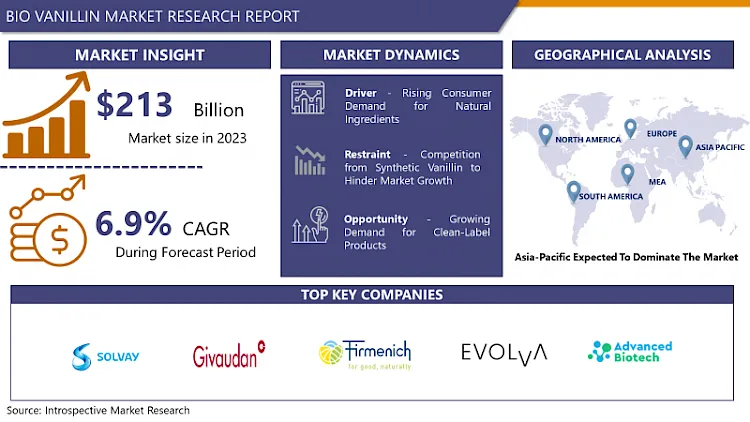Bio Vanillin Market Synopsis
Bio Vanillin Market Size Was Valued at USD 213 Billion in 2023, and is Projected to Reach USD 388.31 Billion by 2032, Growing at a CAGR of 6.9% From 2024-2032.
The global market trend of consumer shifting towards holistic health and opting for natural products than synthetic ones has made bio vanillin, which is obtained from natural resources like vanilla beans, lignin derived from agricultural waste, and ferulic acid, popular. This has now been increasingly noted in the use of products in the food and the beverages sector because of the favourable Flavor of the bio vanillin.
- Synthetic vanillin is normally produced from petrochemicals while bio vanillin is generated from renewable biomass and is therefore regarded as environ- mentally friendly. This is an appealing feature as individuals and businesses who would like to embrace the green initiative at one point or the other will prefer products made from such environmentally sustainable materials.
- New techniques in the field of biotechnology as well as enhance fermentation methods have made the bio vanillin production more economically viable and sustainable. These developments in technology have made it possible to enhance the production capacity with the intent of satisfying the increasing demand in the market with a corresponding increase in quality and affordable prices.
- While bio vanillin is gradually gaining acceptance among consumers, regulatory bodies in different parts of the world are encouraging the use of natural flavorings, thus favouring an increased demand for the bio vanillin. For example, the European Union has set very high standards over the use of artificial additives to food products through its regulatory bodies, thus encouraging the use of the bio vanillin.

Bio Vanillin Market Trend Analysis
Rise in Clean Label Products
- Transcendentally, the authors of the study highlight the growing trend of consumers’ desire for products containing familiar and natural ingredients instead of artificial flavors. Bio vanillin produced from natural and renewable resources such as vanilla beans or through fermentation greatly complements this notion of clean label.
- Clean label products are products which showcase the absence of undesirable substances and components as well as clean processes in the sourcing and processing of food ingredients. Currently bio vanillin has the natural background, so organic and usually environmentally friendly processes of preparation are attractive to buyers.
- While growing from biological sources gives bio vanillin a relatively superior flavor compared to acetaldehyde. This enables manufacturers to produce delicious vanilla products with very little commodity attributes to give high quality products with callable claim.
- Consumer demands to limit artificial flavors, which include particle-based flavors in certain geographical locations, are likely to push manufacturers towards Natural alternatives like bio vanillin in food and beverages.
Increased Focus on Sustainable Sourcing
- Consumers are becoming more environmentally conscious and prioritize brands committed to ethical sourcing practices. Bio vanillin, derived from renewable resources like vanilla beans or fermentation, aligns with this trend as it avoids the environmental impact associated with conventional vanilla bean cultivation.
- Increased demand for transparency in sourcing allows consumers to make informed choices. Bio vanillin producers can showcase their commitment to sustainable practices, building trust and brand loyalty.
- Conventional vanilla bean cultivation can be resource-intensive and strain ecosystems. Bio vanillin production often requires less land, water, and chemicals, minimizing its environmental footprint.
- Sustainable sourcing ensures long-term vanilla bean availability and mitigates the risk of price fluctuations associated with weather events or resource depletion. This fosters stability and predictability for the Bio Vanillin Market.
Bio Vanillin Market Segment Analysis:
Bio Vanillin Market is segmented based on Application and Type
By Application, Food and Beverages segment is expected to dominate the market during the forecast period
- Food and Beverages segment has more than 80% stake in global market as the demand for natural flavors is high especially in baked items, ice-cream, chocolates, and drinks. Clean-label classification makes customers trust bio vanillin over synthetic vanillin and it repeats this testimony.
- Bio vanillin is widely used in perfumes, cosmetics and personal care products due to its fascinating smell, as well as the increasing consumer appearing for natural products. Still, there might be other benefits that could make synthetic vanillin more useful for specific applications.
- Bio vanillin has limited application in pharmaceutical industry, the primary function is to act as a masking agent to enable patient to take bitter medicines. As the product is effective and ecologically sensitive natural, the market for the product is believed to be stable.
- It also effectively combines a carriage with more than a hint of bio vanillin potential to boot. That is why researchers are investigating the uses of polymers in bioplastics, insect repellents, and some areas of treatment. They are indicated below and may add value to future markets.
By Type, Natural segment held the largest share in 2023
- Natural type is obtained by extracting it from the raw material which comes from the vanilla beans through different processes. It is regarded as having the most sophisticated and natural attributes in vanilla and is best suited to the niche food and fragrance industries.
- Nonetheless, natural bio vanillin costs far more than synthetic vanillin because of scarcity of vanilla beans used to manufacture it and involves complex techniques to extract the compound.
- Natural bio vanillin is synthesised through microbial fermentation and this type of vanillin is easily available, cost effective, and can effectively compete with natural vanillin bio production.
- While it is purely white chocolate and creates a comfortable middle ground, it might just be missing undertones that come with natural colouring. This makes Synthetic bio vanillin to be useful in many applications especially in the manufacturing of Foods and beverages where cost of vanillin is a deemed factor.
- Widening the market for the two types of bio vanillin, it would be used for the production of premium products, namely ‘natural bio vanillin’, and used for the large-scale production of vanillin with due consideration to cost-effective synthesis, namely ‘synthetic bio vanillin’.
Bio Vanillin Market Regional Insights:
Asia-Pacific is Expected to Dominate the Market Over the Forecast period
- China and India are wonderful examples where due to the higher disposal income, people are looking forward to consuming more premium food and beverages. Due to the rising awareness toward quality and natural solutions, this region’s consumers are willing to spend more for bio vanillin.
- As mentioned earlier, the Asia-Pacific food industry is gradually expanding, particularly in per-capita processed and convenience foods. Bio vanillin can effectively substitute these chemical flavors and thus, cater for the demand of natural flavors for these products among consumers.
- The information that can be inferred from the passage is that, regulatory bodies in some Asian countries are putting in place stringent measures against the use of artificial flavors. This leads to increased bio vanillin adoption mainly because of the natural and safe synthesis claim associated with the product.
- The supply has also been threatened through the expansion of local bio vanillin producers from Asia-Pacific region thus lowering dependency on imports. This allows achieving the economy of costs and provides for the satisfaction of the specific demands of the regional market.
Active Key Players in the Bio Vanillin Market
- Solvay SA (Belgium)
- Givaudan SA (Switzerland)
- Firmenich SA (Switzerland)
- Evolva Holdings SA (Switzerland)
- Advanced Biotech (United States)
- Borregaard (Norway)
- Jiaxing Zhonghua Chemical Co., Ltd. (China)
- Prinova Group LLC (United States)
- Lesaffre (France)
- Synerzine (Netherlands)
- Aurochemicals (United States)
- Shanghai Xinjia Food Additive Co., Ltd. (China)
- Ennolys (France)
- Anhui Bayi Chemical Industry Co., Ltd. (China)
- Jiaxing Nice Chemicals Co., Ltd. (China)
- Nutra Food Ingredients LLC (United States)
- Anhui Fengle Perfume Co., Ltd. (China)
- Xiamen Hisunny Chemical Co., Ltd. (China)
- Guangdong Sino Flavor Ingredients Co., Ltd. (China)
- Zhongbei Northland Bio-Chem Industry Co., Ltd. (China)
- others
Key Industry Developments in the Bio Vanillin Market:
- Solvay announced in that it intends to allocate funds towards the enhancement of its biotechnology capacities and the advancement of natural ingredient development at the Cipan manufacturing facility of Suanfarma, located in Lisbon, Portugal.
|
Global Bio Vanillin Market |
|||
|
Base Year: |
2023 |
Forecast Period: |
2024-2032 |
|
Historical Data: |
2017 to 2023 |
Market Size in 2023: |
USD 227.70 Bn. |
|
Forecast Period 2024-32 CAGR: |
6.9% |
Market Size in 2032: |
USD 388.31Bn. |
|
Segments Covered: |
By Application |
|
|
|
By Type |
|
||
|
By Region |
|
||
|
Key Market Drivers: |
|
||
|
Key Market Restraints: |
|
||
|
Key Opportunities: |
|
||
|
Companies Covered in the report: |
|
||
- INTRODUCTION
- RESEARCH OBJECTIVES
- RESEARCH METHODOLOGY
- RESEARCH PROCESS
- SCOPE AND COVERAGE
- Market Definition
- Key Questions Answered
- MARKET SEGMENTATION
- EXECUTIVE SUMMARY
- MARKET OVERVIEW
- GROWTH OPPORTUNITIES BY SEGMENT
- MARKET LANDSCAPE
- PORTER’S FIVE FORCES ANALYSIS
- Bargaining Power Of Supplier
- Threat Of New Entrants
- Threat Of Substitutes
- Competitive Rivalry
- Bargaining Power Among Buyers
- INDUSTRY VALUE CHAIN ANALYSIS
- MARKET DYNAMICS
- Drivers
- Restraints
- Opportunities
- Challenges
- MARKET TREND ANALYSIS
- REGULATORY LANDSCAPE
- PESTLE ANALYSIS
- PRICE TREND ANALYSIS
- PATENT ANALYSIS
- TECHNOLOGY EVALUATION
- MARKET IMPACT OF THE RUSSIA-UKRAINE WAR
- Geopolitical Market Disruptions
- Supply Chain Disruptions
- Instability in Emerging Markets
- ECOSYSTEM
- PORTER’S FIVE FORCES ANALYSIS
- BIO VANILLIN MARKET BY APPLICATION (2017-2032)
- BIO VANILLIN MARKET SNAPSHOT AND GROWTH ENGINE
- MARKET OVERVIEW
- FOOD AND BEVERAGES
- Introduction And Market Overview
- Historic And Forecasted Market Size in Value (2017 – 2032F)
- Historic And Forecasted Market Size in Volume (2017 – 2032F)
- Key Market Trends, Growth Factors And Opportunities
- Geographic Segmentation Analysis
- FRAGRANCE
- PHARMACEUTICALS
- BIO VANILLIN MARKET BY TYPE (2017-2032)
- BIO VANILLIN MARKET SNAPSHOT AND GROWTH ENGINE
- MARKET OVERVIEW
- NATURAL
- Introduction And Market Overview
- Historic And Forecasted Market Size in Value (2017 – 2032F)
- Historic And Forecasted Market Size in Volume (2017 – 2032F)
- Key Market Trends, Growth Factors And Opportunities
- Geographic Segmentation Analysis
- SYNTHETIC
- COMPANY PROFILES AND COMPETITIVE ANALYSIS
- COMPETITIVE LANDSCAPE
- Competitive Positioning
- Bio Vanillin Market Share By Manufacturer (2023)
- Industry BCG Matrix
- Heat Map Analysis
- Mergers & Acquisitions
- SOLVAY SA (BELGIUM)
- Company Overview
- Key Executives
- Company Snapshot
- Role of the Company in the Market
- Sustainability and Social Responsibility
- Operating Business Segments
- Product Portfolio
- Business Performance (Production Volume, Sales Volume, Sales Margin, Production Capacity, Capacity Utilization Rate)
- Key Strategic Moves And Recent Developments
- SWOT Analysis
- GIVAUDAN SA (SWITZERLAND)
- FIRMENICH SA (SWITZERLAND)
- EVOLVA HOLDINGS SA (SWITZERLAND)
- ADVANCED BIOTECH (UNITED STATES)
- BORREGAARD (NORWAY)
- JIAXING ZHONGHUA CHEMICAL CO., LTD. (CHINA)
- PRINOVA GROUP LLC (UNITED STATES)
- LESAFFRE (FRANCE)
- SYNERZINE (NETHERLANDS)
- AUROCHEMICALS (UNITED STATES)
- SHANGHAI XINJIA FOOD ADDITIVE CO., LTD. (CHINA)
- ENNOLYS (FRANCE)
- ANHUI BAYI CHEMICAL INDUSTRY CO., LTD. (CHINA)
- JIAXING NICE CHEMICALS CO., LTD. (CHINA)
- NUTRA FOOD INGREDIENTS LLC (UNITED STATES)
- ANHUI FENGLE PERFUME CO., LTD. (CHINA)
- XIAMEN HISUNNY CHEMICAL CO., LTD. (CHINA)
- GUANGDONG SINO FLAVOR INGREDIENTS CO., LTD. (CHINA)
- ZHONGBEI NORTHLAND BIO-CHEM INDUSTRY CO., LTD. (CHINA)
- COMPETITIVE LANDSCAPE
- GLOBAL BIO VANILLIN MARKET BY REGION
- OVERVIEW
- NORTH AMERICA
- Key Market Trends, Growth Factors And Opportunities
- Key Manufacturers
- Historic And Forecasted Market Size By Application
- Historic And Forecasted Market Size By Type
- Historic And Forecasted Market Size By Country
- USA
- Canada
- Mexico
- EASTERN EUROPE
- Key Market Trends, Growth Factors And Opportunities
- Key Manufacturers
- Historic And Forecasted Market Size By Segments
- Historic And Forecasted Market Size By Country
- Russia
- Bulgaria
- The Czech Republic
- Hungary
- Poland
- Romania
- Rest Of Eastern Europe
- WESTERN EUROPE
- Key Market Trends, Growth Factors And Opportunities
- Key Manufacturers
- Historic And Forecasted Market Size By Segments
- Historic And Forecasted Market Size By Country
- Germany
- United Kingdom
- France
- The Netherlands
- Italy
- Spain
- Rest Of Western Europe
- ASIA PACIFIC
- Key Market Trends, Growth Factors And Opportunities
- Key Manufacturers
- Historic And Forecasted Market Size By Segments
- Historic And Forecasted Market Size By Country
- China
- India
- Japan
- South Korea
- Malaysia
- Thailand
- Vietnam
- The Philippines
- Australia
- New-Zealand
- Rest Of APAC
- MIDDLE EAST & AFRICA
- Key Market Trends, Growth Factors And Opportunities
- Key Manufacturers
- Historic And Forecasted Market Size By Segments
- Historic And Forecasted Market Size By Country
- Turkey
- Bahrain
- Kuwait
- Saudi Arabia
- Qatar
- UAE
- Israel
- South Africa
- SOUTH AMERICA
- Key Market Trends, Growth Factors And Opportunities
- Key Manufacturers
- Historic And Forecasted Market Size By Segments
- Historic And Forecasted Market Size By Country
- Brazil
- Argentina
- Rest of South America
- INVESTMENT ANALYSIS
- ANALYST VIEWPOINT AND CONCLUSION
- Recommendations and Concluding Analysis
- Potential Market Strategies
|
Global Bio Vanillin Market |
|||
|
Base Year: |
2023 |
Forecast Period: |
2024-2032 |
|
Historical Data: |
2017 to 2023 |
Market Size in 2023: |
USD 227.70 Bn. |
|
Forecast Period 2024-32 CAGR: |
6.9% |
Market Size in 2032: |
USD 388.31Bn. |
|
Segments Covered: |
By Application |
|
|
|
By Type |
|
||
|
By Region |
|
||
|
Key Market Drivers: |
|
||
|
Key Market Restraints: |
|
||
|
Key Opportunities: |
|
||
|
Companies Covered in the report: |
|
||
Frequently Asked Questions :
The forecast period in the Bio Vanillin Market research report is 2024-2032.
Solvay SA (Belgium),Givaudan SA (Switzerland),Firmenich SA (Switzerland),Evolva Holdings SA (Switzerland), Advanced Biotech (United States),Borregaard (Norway), Jiaxing Zhonghua Chemical Co., Ltd. (China),Prinova Group LLC (United States),Lesaffre (France),Synerzine (Netherlands), Aurochemicals (United States),Shanghai Xinjia Food Additive Co., Ltd. (China),Ennolys (France),Anhui Bayi Chemical Industry Co., Ltd. (China),Jiaxing Nice Chemicals Co., Ltd. (China),Nutra Food Ingredients LLC (United States),Anhui Fengle Perfume Co., Ltd. (China),Xiamen Hisunny Chemical Co., Ltd. (China),Guangdong Sino Flavor Ingredients Co., Ltd. (China),Zhongbei Northland Bio-Chem Industry Co., Ltd. (China) and Others
The Bio Vanillin Market is segmented into By Application, By Type and region. By Application (Food and Beverages, Fragrance, Pharmaceuticals), By Type (Natural and Synthetic) and By region, it is analyzed across North America (U.S.; Canada; Mexico), Europe (Germany; U.K.; France; Italy; Russia; Spain, etc.), Asia-Pacific (China; India; Japan; Southeast Asia, etc.), South America (Brazil; Argentina, etc.), Middle East & Africa (Saudi Arabia; South Africa, etc.).
Bio vanillin is a natural alternative to synthetic vanillin, the familiar flavoring compound found in vanilla beans. Unlike its synthetic counterpart derived from petrochemicals, bio vanillin is extracted from renewable sources like vanilla beans themselves or produced through microbial fermentation. This fermentation process utilizes microorganisms to convert natural substrates like wood or rice bran into vanillin. Bio vanillin offers the same pleasant vanilla taste and aroma as synthetic vanillin, but with the added benefit of being natural and often more sustainable in its production. This makes it a popular choice for manufacturers seeking clean-label food and beverage products, fragrances, and even some pharmaceuticals.
Bio Vanillin Market Size Was Valued at USD 213.00 Billion in 2023, and is Projected to Reach USD 388.31 Billion by 2032, Growing at a CAGR of 6.9% From 2024-2032.











